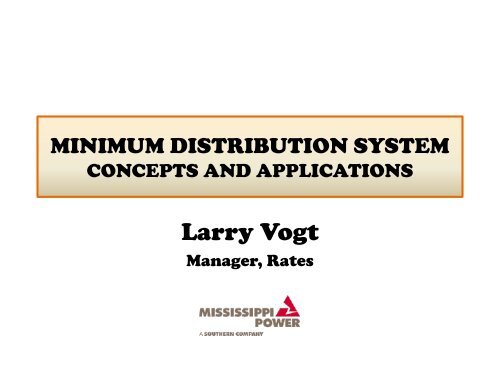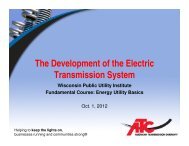Minimum Distribution System Concepts and Applications
Minimum Distribution System Concepts and Applications
Minimum Distribution System Concepts and Applications
You also want an ePaper? Increase the reach of your titles
YUMPU automatically turns print PDFs into web optimized ePapers that Google loves.
MINIMUM DISTRIBUTION SYSTEM<br />
CONCEPTS AND APPLICATIONS<br />
Larry Vogt<br />
Manager, Rates
<strong>Minimum</strong> <strong>Distribution</strong> <strong>System</strong><br />
What is MDS<br />
MDS is an analysis module of the cost-of-service study in<br />
which distribution investment is classified between<br />
dem<strong>and</strong>-related <strong>and</strong> customer-related cost components.<br />
Why is MDS important<br />
MDS is key to determining the monthly fixed costs of<br />
providing basic electric service. It provides a cost<br />
justification basis for the Customer Charge portion of the<br />
rate structure.
Basic Cost Components<br />
The classification step of the cost-of-service study assigns<br />
all of the functionalized cost elements to the cost causation<br />
components of Customer, Dem<strong>and</strong>, <strong>and</strong> Energy.<br />
• Energy-related costs – variable costs which are<br />
dependent on kWh requirements.<br />
• Dem<strong>and</strong>-related costs – fixed costs which are dependent<br />
on kW requirements.<br />
• Customer-related costs – fixed costs which are<br />
independent of load or energy requirements.<br />
3
Cost Classification Categories<br />
• CUSTOMER COSTS<br />
<strong>Minimum</strong> <strong>Distribution</strong><br />
• DEMAND COSTS<br />
• ENERGY COSTS
The Access Function Of The<br />
<strong>Distribution</strong> <strong>System</strong><br />
• All primary <strong>and</strong> secondary<br />
customers are connected to<br />
a distribution voltage<br />
source, i.e., a local<br />
substation.<br />
SUB<br />
• There is a physical path<br />
which brings voltage to the<br />
customer’s premise.<br />
• Maintaining the voltage path<br />
ensures customer access to<br />
electrical power.<br />
5
The Capacity Function Of The<br />
<strong>Distribution</strong> <strong>System</strong><br />
• Primary <strong>and</strong> secondary<br />
distribution system facilities<br />
<strong>and</strong> lines must be sized to<br />
adequately h<strong>and</strong>le the<br />
customers’ dem<strong>and</strong> for<br />
power.<br />
• Electric service facilities are<br />
rated in terms of kVA<br />
capacity (conductors rated<br />
in terms of ampacity).<br />
Customer Load<br />
Feeder Load<br />
6
<strong>Distribution</strong> <strong>System</strong><br />
Lines <strong>and</strong> Facilities<br />
FERC<br />
Description<br />
360 L<strong>and</strong> <strong>and</strong> L<strong>and</strong> Rights<br />
361 Structures<br />
362 Station Equipment<br />
S<br />
336.4 MCM ACSR<br />
SUB<br />
M<br />
N.C.<br />
R<br />
363 Storage Battery Equipment<br />
364 Poles, Towers & Fixtures<br />
365 OH Conductors & Devices<br />
• Switches<br />
4/0 CU<br />
NO. 2 AL<br />
C/N<br />
75<br />
N.C.<br />
N.C.<br />
1,500 cKVAR<br />
• Reclosers & Sectionalizers<br />
366 UG Conduit<br />
367 UG Conductors & Devices<br />
333-333-333<br />
50-50-50<br />
368 Line Transformers<br />
• Regulators<br />
• Capacitors<br />
• Cutouts<br />
15<br />
1/0 CU<br />
• Arresters<br />
369 Services<br />
370 Meters<br />
25 37.5<br />
N.O.<br />
373 Street Lighting<br />
7
Objective of the <strong>Minimum</strong><br />
<strong>Distribution</strong> <strong>System</strong> Analysis<br />
To assess each device utilized in the distribution system in<br />
terms of its “mission” in order to determine if its function is:<br />
Dependent on kW load requirements <strong>and</strong> therefore<br />
dem<strong>and</strong> related,<br />
or<br />
Independent of kW load requirements <strong>and</strong> therefore<br />
customer related.<br />
8
Customer or Dem<strong>and</strong><br />
9
Capacitor-Based Voltage Control<br />
MW<br />
SUB<br />
FEEDER<br />
132 V<br />
+10%<br />
120 V<br />
108 V<br />
-10%<br />
TIME<br />
DISTANCE<br />
10
Customer or Dem<strong>and</strong><br />
11
Protection Scheme<br />
Temporary Fault Condition<br />
SUB<br />
CB<br />
R<br />
12
Protection Scheme<br />
Permanent Fault Condition<br />
SUB<br />
CB<br />
R<br />
13
Protection Scheme<br />
Permanent Fault Condition – No Load<br />
SUB<br />
CB<br />
R<br />
14
Customer or Dem<strong>and</strong>
Classification of <strong>Distribution</strong><br />
Plant for the Cost-of-Service<br />
Dem<strong>and</strong><br />
Customer<br />
<strong>Distribution</strong> Substations<br />
X<br />
Primary Lines* X X<br />
Line Transformers* X X<br />
Secondary Lines* X X<br />
Other Line Equipment* X X<br />
Service Lines<br />
Meters<br />
X<br />
X<br />
* <strong>Minimum</strong> <strong>Distribution</strong> <strong>System</strong> facilities.<br />
16
Zero-Intercept Methodology<br />
Applied to:<br />
• Line Transformers<br />
• Conductors<br />
• Poles<br />
THE Y-AXIS<br />
INTERCEPT<br />
UNIT<br />
COSTS<br />
×<br />
×<br />
×<br />
×<br />
IS THE UNIT<br />
COST OF<br />
ZERO CAPACITY<br />
×<br />
COST OF A STANDARD<br />
SIZE UNIT<br />
CAPACITY<br />
17
Line Transformers<br />
18
Weighted Linear Regression<br />
For <strong>Distribution</strong> Line Transformers<br />
m<br />
=<br />
[ N×<br />
∑nXY] − [ ∑nX×<br />
∑nY]<br />
2<br />
[ N×<br />
nX ] − [ nX] 2<br />
∑<br />
SLOPE<br />
∑<br />
N = Total number of all transformers of<br />
a given type, e.g., 59,800 7.2 kV -<br />
120/240 V, single-bushing, polemount<br />
units<br />
n = Number of a given size transformer,<br />
e.g., 9,935 15 kVA<br />
b<br />
y-INTERCEPT<br />
⎡ ⎤<br />
∑nY<br />
⎢∑nX<br />
= − m×<br />
⎥<br />
N ⎢ N ⎥<br />
⎣ ⎦<br />
X = Transformer size in kVA, e.g.,<br />
5, 7.5, 10, 15, etc.<br />
Y = Transformer unit cost in $ per unit,<br />
e.g., $724.48 (cost of a 15 kVA unit)<br />
19
Zero-Intercept Example<br />
Single-Phase Overhead Transformers<br />
1. ZERO-INTERCEPT: $463.975/transformer<br />
Based on various kVA sizes of 7.2 kV - 120/240 V, single bushing, polemount<br />
transformers<br />
2. TOTAL NUMBER OF OVERHEAD TRANSFORMERS: 98,278<br />
CUSTOMER COMPONENT = $ 463.975 × 98,728 = $45,807,307<br />
3. TOTAL OVERHEAD TRANSFORMER COST: $109,960,813<br />
DEMAND COMPONENT = $109,960,813 - $45,807,307 = $64,153,506<br />
CUSTOMER COMPONENT = 41.7%<br />
DEMAND COMPONENT = 58.3%<br />
20
Zero-Intercept Analysis<br />
The Problem With Vintage Costs<br />
$2,000<br />
$1,800<br />
$1,600<br />
$1,400<br />
Analysis of Pad-Mount Line Transformers<br />
Based on Booked Installed Costs<br />
Unit Cost<br />
$1,200<br />
$1,000<br />
$800<br />
$600<br />
$400<br />
$200<br />
3Φ<br />
1Φ<br />
$0<br />
0 10 20 30 40 50 60 70 80 90 100<br />
kVA<br />
21
Zero-Intercept Analysis<br />
Use of Current Costs<br />
$15,000<br />
Analysis of Pad-Mount Line Transformers<br />
Based on Rebuild Costs<br />
$13,500<br />
$12,000<br />
3Φ<br />
Unit Cost<br />
$10,500<br />
$9,000<br />
$7,500<br />
$6,000<br />
$4,500<br />
$3,000<br />
$1,500<br />
1Φ<br />
$0<br />
0 10 20 30 40 50 60 70 80 90 100<br />
kVA<br />
22
Primary <strong>and</strong> Secondary<br />
Conductors <strong>and</strong> Poles<br />
PRIMARY<br />
NEUTRAL<br />
SECONDARY<br />
23
Overhead Conductors<br />
Relative Frequency <strong>Distribution</strong><br />
50%<br />
45%<br />
40%<br />
80%<br />
70%<br />
60%<br />
50%<br />
35%<br />
30%<br />
25%<br />
20%<br />
15%<br />
40%<br />
30%<br />
20%<br />
10%<br />
0%<br />
CU BARE CU WP AL BARE AL WP<br />
10%<br />
5%<br />
0%<br />
4 ACSR 2 ACSR 1/0 ACSR 4/0 ACSR 336 ACSR 477 ACSR 795 ACSR<br />
477 AAC 795 AAC 1,351 AAC<br />
24
Weighted Linear Regression<br />
For <strong>Distribution</strong> Conductors<br />
m<br />
=<br />
[ N×<br />
∑nXY] − [ ∑nX×<br />
∑nY]<br />
2<br />
[ N×<br />
nX ] − [ nX] 2<br />
∑<br />
SLOPE<br />
∑<br />
N = Total feet of all conductors of a<br />
given type, e.g., 47,557,568 ft of<br />
ACSR conductors<br />
n = Number of feet of a given size<br />
conductor, e.g., 26,194,939 ft of<br />
#2 ACSR<br />
b<br />
y-INTERCEPT<br />
⎡ ⎤<br />
∑nY<br />
⎢∑nX<br />
= − m×<br />
⎥<br />
N ⎢ N ⎥<br />
⎣ ⎦<br />
X = Conductor size in MCM (a #2<br />
wire is 66.36 MCM), e.g., 26.24,<br />
41.74, 52.62, 66.36, etc.<br />
Y = Conductor unit cost in $ per feet,<br />
e.g., $0.659/ft (cost of a #2 ACSR<br />
conductor)<br />
25
Zero-Intercept Example<br />
Primary Overhead Conductor<br />
1. ZERO-INTERCEPT: $0.396/ft<br />
Based on various MCM sizes of bare ACSR conductors<br />
2. TOTAL LENGTH OF PRIMARY CONDUCTORS: 15,708,000 ft<br />
PRIMARY CIRCUIT LENGTH: 15,708,000 × 2 = 31,416,000 ft<br />
CUSTOMER COMPONENT = $0.396 × 29,898,000* = $11,827,081<br />
* <strong>Minimum</strong> <strong>Distribution</strong> <strong>System</strong> Length<br />
3. TOTAL PRIMARY CONDUCTOR COST: $56,416,253<br />
DEMAND COMPONENT = $56,416,253 - $11,827,081 = $44,589,172<br />
CUSTOMER COMPONENT = 21.0%<br />
DEMAND COMPONENT = 79.0%<br />
26
Determination Of Overhead<br />
Circuit Lengths For The MDS<br />
TOTAL POLE MILES<br />
PRIMARY<br />
SUB<br />
PRIMARY NEUTRAL COMMON NEUTRAL SECONDARY NEUTRAL<br />
SECONDARY<br />
UNDERBUILD<br />
SECONDARY<br />
TAPS<br />
27
UNDERGROUND<br />
PRIMARY CABLE<br />
CONCENTRIC<br />
NEUTRAL<br />
CONDUCTOR
CONDUIT FOR<br />
UNDERGROUND CABLES<br />
RIGID PVC<br />
FLEXIBLE
<strong>Distribution</strong> Poles<br />
Types Of Materials<br />
100%<br />
90%<br />
80%<br />
70%<br />
60%<br />
50%<br />
40%<br />
30%<br />
20%<br />
10%<br />
1.0%<br />
0.9%<br />
0.8%<br />
0.7%<br />
0.6%<br />
0.5%<br />
0.4%<br />
0.3%<br />
0.2%<br />
0.1%<br />
0.0%<br />
ALUMINUM CONCRETE FIBERGLASS STEEL<br />
0%<br />
ALUMINUM CONCRETE FIBERGLASS STEEL WOOD<br />
30
Pole Heights<br />
Relative Frequency <strong>Distribution</strong><br />
40%<br />
35%<br />
30%<br />
25%<br />
20%<br />
15%<br />
10%<br />
5%<br />
0%<br />
30' 35' 40' 45' 50' 55' 60' 65' 70' 75' 80' 85' 90' 95'<br />
POLE HEIGHTS<br />
31
Pole Line Routing<br />
SUB<br />
32
Clearance Requirements<br />
Poles lines must be designed to ensure proper safety<br />
clearances, such as specified in the National Electric<br />
Safety Code (NESC), Section 23.<br />
The NESC provides specific minimum clearances of<br />
power lines located over:<br />
• Roadways, parking lots, driveways, pedestrian areas, railroad<br />
track rails, water ways, etc.<br />
• Other electric conductors <strong>and</strong> services, trolley/electric train<br />
cables, communications cables, etc.<br />
33
Pole Line Grading<br />
IMPROPER GRADING:<br />
POLES ALL HAVE THE SAME HEIGHT<br />
PROPER GRADING:<br />
POLES WITH VARYING HEIGHTS<br />
34
<strong>Distribution</strong> Pole Classification<br />
Conclusion On Pole Height<br />
• Pole lines are built to connect customers to the<br />
power source, i.e., the substation. The routing of<br />
these lines is predominantly a function of where<br />
customers are located.<br />
• Pole height requirements are predominantly a<br />
function of clearances <strong>and</strong> line grading, which are<br />
related to safety <strong>and</strong> mechanical design.<br />
• Thus, pole height is not a major function of load.<br />
35
Pole Class<br />
36
St<strong>and</strong>ard Pole Classes<br />
Example: 35’ Wood Pole<br />
No. 1<br />
39.0”<br />
No. 2<br />
36.5”<br />
No. 3<br />
34.0’<br />
No. 4<br />
31.5”<br />
No. 5<br />
29.0”<br />
No. 6<br />
27.0”<br />
No. 7<br />
25.0”<br />
MINIMUM CIRCUMFERENCE OF SOUTHERN YELLOW PINE POLES (@ GROUND LINE)<br />
37
Pole Classes<br />
Relative Frequencies By Height<br />
60%<br />
50%<br />
40%<br />
30%<br />
20%<br />
10%<br />
7<br />
6<br />
5<br />
4<br />
3<br />
2<br />
1<br />
0%<br />
POLE CLASS<br />
45 FT POLES 40 FT POLES 35 FT POLES 30 FT POLES<br />
38
Pole Class Requirements<br />
Based On Transformer Capacity<br />
0<br />
TRANSFORMER kVA<br />
10 15 25 37.5 50 75 100 167 250<br />
1<br />
2<br />
POLE CLASS<br />
3<br />
4<br />
5<br />
6<br />
7<br />
1 TRANSFORMER 2 TRANSFORMERS 3 TRANSFORMERS<br />
39
<strong>Distribution</strong> Pole Classification<br />
Conclusion On Pole Class<br />
• The physical sizes <strong>and</strong> weights of line transformers<br />
<strong>and</strong> wires are related to their current carrying<br />
capabilities.<br />
• Pole class must be increased (i.e., going from 7 to 1)<br />
to carry heavy mechanical loads caused by large line<br />
transformers <strong>and</strong> conductors (3Φ lines are indicative<br />
of greater electrical load density than 1Φ lines).<br />
• Thus, pole class is predominantly a function of load.<br />
40
Pole Capacity<br />
Poles have no electrical<br />
capacity component, but they<br />
do have a mechanical capacity<br />
(strength) component that can<br />
be viewed as a proxy for<br />
electrical loading.<br />
Pole class (or circumference)<br />
can represent loading capability<br />
for wood poles, but it does not<br />
work for steel or concrete poles<br />
since different classes can have<br />
the same physical dimensions.<br />
Ground line moment capacities<br />
do differ by class for all poles.<br />
Example: 35’ 5-C Pole<br />
Transverse Wind<br />
Load of 1,200 lb<br />
GLMC = 33,000 ft-lbs = 33 kips<br />
41
Weighted Linear Regression<br />
For <strong>Distribution</strong> Poles<br />
m<br />
=<br />
[ N×<br />
∑nXY] − [ ∑nX×<br />
∑nY]<br />
2<br />
[ N×<br />
nX ] − [ nX] 2<br />
∑<br />
SLOPE<br />
∑<br />
N = Total feet of all poles of a given<br />
type, e.g., 55,642 ft of 40 ft wood<br />
poles<br />
n = Number of feet of a given size pole<br />
based on its GLMC, e.g., 21,137 ft<br />
of 76.80 kilopounds (kips) poles<br />
b<br />
y-INTERCEPT<br />
⎡ ⎤<br />
∑nY<br />
⎢∑nX<br />
= − m×<br />
⎥<br />
N ⎢ N ⎥<br />
⎣ ⎦<br />
X = Ground Line Moment Capacity in<br />
kips, e.g., 48.0, 60.8, 76.8, 96.0, etc.<br />
Y = Pole unit cost in $ per feet, e.g.,<br />
$12.05/ft (cost of a 76.8 kips pole)<br />
42
Zero-Intercept Example<br />
Wood Poles<br />
1. ZERO-INTERCEPT: $7.883/ft<br />
Based on various kip ratings of 40’ southern pine poles<br />
2. TOTAL LINEAR FEET OF WOOD POLES: 5,579,390 ft<br />
CUSTOMER COMPONENT = $7.883 × 5,579,390 = $43,982,773<br />
3. TOTAL WOOD POLE COST: $66,254,744<br />
DEMAND COMPONENT = $66,254,744 - $43,982,773 = $22,271,971<br />
CUSTOMER COMPONENT = 66.4%<br />
DEMAND COMPONENT = 33.6%<br />
43
Example MDS Analysis Results<br />
Poles, Transformers, <strong>and</strong> Conductors<br />
Customer Dem<strong>and</strong><br />
Poles<br />
• Wood 66.4% 33.6%<br />
• Concrete 47.3% 52.7%<br />
• Steel 57.5% 42.5%<br />
Transformers<br />
• 1Φ OH* 41.7% 58.3%<br />
• 1Φ UG** 61.5% 38.5%<br />
• 3Φ UG** 34.2% 65.8%<br />
Customer Dem<strong>and</strong><br />
Conductors<br />
Primary<br />
• Bare ACSR OH 21.0% 79.0%<br />
• 15 kV CN UG* 57.4% 42.6%<br />
Secondary<br />
• WP AL OH 38.4% 61.6%<br />
• Duplex OH 31.4% 68.6%<br />
• 1-Conductor UG* 60.7% 39.3%<br />
* Basis for classifying transformer vaults<br />
** Basis for classifying transformer pads<br />
* Basis for classifying conduit<br />
44
Example MDS Analysis Results<br />
<strong>Distribution</strong> Line Devices<br />
Primary<br />
Secondary<br />
Customer Dem<strong>and</strong> Customer Dem<strong>and</strong><br />
Regulators & Capacitors 100%<br />
Reclosers <strong>and</strong> Sectionalizers 100%<br />
Cutouts & Arresters<br />
• Line Transformers (OH) 41.7% 58.3%<br />
• Regulators & Capacitors 100%<br />
• Reclosers & Sectionalizers 100%<br />
• Line Protection 100%<br />
Bypass Switches<br />
• Regulators 100%<br />
• Reclosers & Sectionalizers 100%<br />
OH Line Switches* 21.0% 79.0%<br />
UG Line Switches* 57.4% 42.6%<br />
* Based on conductors<br />
45
Q&A<br />
Larry Vogt







![[Hybrid Synergy Drive Knowledge is Power]](https://img.yumpu.com/35232059/1/190x143/hybrid-synergy-drive-knowledge-is-power.jpg?quality=85)


